By Aidan
In the 2025 Norwegian parliamentary election on 8 September 2025, Norway’s left-of-centre parties held onto a hard fought majority, while the far-right received a massive surge. Incumbent Prime Minister Jonas Gahr Støre will remain Prime Minister of Norway.
Initial Collapse
For much of the period leading up to the 2025 election, Norway’s left-wing collection of parties, termed as the Red Bloc, was polling significantly below the right-wing parties known as the Blue Bloc. The Blue Bloc was polling at around 100 seats while the Red Bloc was floundering at just under 70 seats up until 2025. This was attributed to Norway’s centre-left government of the Labour Party supported by the Centre Party and Socialist Left’s unpopularity due to repeated scandals in the cabinet.

Labour Party ministers resigned over tax fraud, sexual harassment allegations as well as plagiarism affairs, leading to rising distrust in the government. Furthermore, right-wing populist parties such as the Progress Party joined a wave of far-right parties across Europe, surging throughout much of 2024.
Leading in Polls
After a cabinet shuffle in early 2025, the Labour government introduced former NATO secretary-general Jens Stoltenberg into the cabinet, leading to a polling surge for Labour. While other affiliated Red Bloc parties continued to poll poorly, Labour returned to leading the polls over both the far-right Progress Party and the centre-right Conservatives.

Also contributing to the left-wing surge were various controversies surrounding the Norwegian sovereign wealth fund supporting the Israeli companies. The Socialist Left said it would only support a future Labour government if it divested from all companies involved in what it called “Israel’s illegal warfare in Gaza”. While Labour rejected the demand, it grew increasingly clear that any Labour government would require Socialist Left support, influencing Norwegian policy in the Gaza War.
Election Results
In the end, the Red Bloc received 88 seats to the Blue Bloc’s 81, allowing Støre to continue in his role as Prime Minister of Norway, albeit with necessary support from each of the left-wing parties. These parties include the agrarian Centre Party, the Socialist Left, the Greens and the socialist-communist Red Party.

Meanwhile, the Norwegian right has also been reshaped by the election. While the Conservatives were previously the dominant force of the Norwegian right, they were relegated to a distant 3rd while the further right Progress Party made large gains to come in 2nd. In fact, near the end of the campaign, the Prime Minister candidates were described as incumbent Labour PM Støre for the Red Bloc and Progress Party leader Listhaug for the Blue Bloc.
The election results have marked a strong stance by the Norwegian public to continue to support the welfare state in Norway, as well as the system regarding the sovereign wealth fund. A clear divide in Norwegian politics has become clear, with the redistributionist left-wing led by Labour and the capitalist right-wing led by the Progress Party.
More from Wake Up Singapore:-
Landslide Victory for Sri Lanka’s Leftist Alliance in Parliamentary Elections
Discord Votes Propel Sushila Karki as Nepal’s First Woman Prime Minister
If you have a story or a tip-off, email admin@wakeup.sg or get in touch via Whatsapp at 8882 5913.
Interested in advertising on our media channels? Reach out to us at admin@wakeup.sg!
Since you have made it to the end of the article, follow Wake Up Singapore on Telegram and X!
Wake Up Singapore is a volunteer-run site that covers alternative views in Singapore. If you want to volunteer with us, sign up here!
If you can, please do consider buying a mug or two to support Wake Up Singapore’s work!







